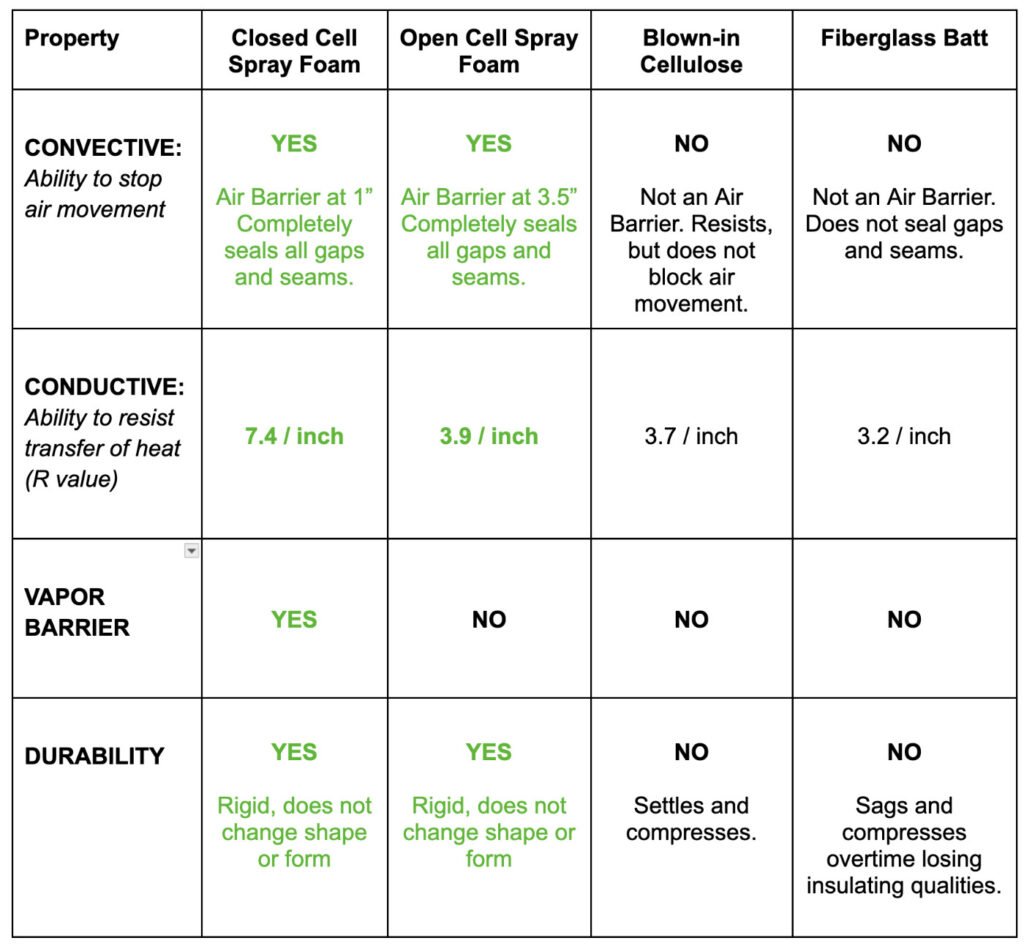Primary cause of efficiency loss in a house is air leakage. Spray foam is the only insulation product that conforms to every inch of your property, creating the most energy efficient thermal envelope available to date. Spray foam seals air leaks and insulates in one shot.
Its unique characteristics contribute to a healthier, more comfortable, and energy-efficient environment within a home.

Convection, Conduction and Radiation are the three ways in which the heat is transferred into or out of a home. Convection and Conduction are the two most relevant properties in evaluating insulation materials.
Convection refers to the transfer of heat through the movement of air. Conduction is a direct transfer of heat from one material touching another material.
You can feel convective heat transfer when you open a house door on a cold or a hot day and the conditioned air escapes your house. You can feel conductive heat transfer when touching a door on a very cold day or simply when you touch a hot cup of coffee.
Insulating materials in your home act to slow or stop the convective and conductive transfer of heat throughout the walls, floors and the attic.
Spray foam insulation is the only insulating product that combines high resistance to thermal conductivity with an effective barrier against air movement.
Neither fiberglass or cellulose insulation stop air flow. Spray foam air-seals and insulates in one shot.
Imagine wearing just a heavy sweater on a cold windy day. You will feel the cold with each gust of wind. But if you wear just a windbreaker over the sweater you will stay warm.
Spray foam is your windbreaker and your sweater as it combines both qualities: effective air-sealing and high resistance to conductivity (R value).
In the video above three types of insulation are installed in their individual compartments in a plexiglass display. A fan blows air from the bottom of the display into each compartment. A ping pong ball sits atop a tube connected to each compartment. The air flows easily through both, the pink fiberglass and the cellulose suspending those ping pong balls in the air. In the middle compartment just 2 inches of closed cell spray foam completely block off the air flow. In fact, closed cell foam stops air flow at even 1 inch thickness.
ASTM E 2178 is a standard test method developed by the American Society for Testing and Materials (ASTM) for determining the air permeance of building materials. Specifically, it measures the rate at which air can pass through a material. An effective air barrier under ASTM E 2178 is a material or system that significantly inhibits air leakage through the building envelope.
Closed cell spray foam is an Air Barrier under ASTM E 2178 at just 1” and open cell spray foam is an Air Barrier at just 3.5”. Neither fiberglass nor cellulose achieve the Air Barrier standard under this test.
Furthermore, both fiberglass and cellulose are prone to sagging and deformation, which creates large openings for air flow. Spray foam remains rigid for the life of the home.

Spray foam not only insulates against temperature fluctuations but also serves as an effective sound barrier. Its dense composition reduces noise transmission, creating a quieter and more peaceful indoor environment. This makes it an ideal choice for homes, offices, and multi-family buildings.
Once applied, spray foam maintains its insulative properties for the lifetime of the building. Unlike fiberglass or cellulose, which can sag or settle over time, spray foam remains in place and does not degrade. This ensures long-term performance without the need for replacement or maintenance.
Many spray foam products are available in eco-friendly formulations, utilizing recycled materials and renewable resources that reduce the overall environmental impact. By increasing your building’s energy efficiency, spray foam also helps reduce your carbon footprint. We use premium materials with over 25% of recycled and renewable content such as soybean oil. Ask your contractor about the renewables and recyclable content in the materials that they use.
At Cloud9 we specialize in providing high-quality spray foam insulation solutions tailored to meet your specific needs. Our experienced professionals are dedicated to enhancing your property’s energy efficiency, comfort, and durability through top-notch installation services.
Ready to experience the unparalleled benefits of spray foam insulation? Contact us today to schedule a free consultation and discover how we can help you achieve peak performance for your home or business.
© Cloud9Home Performance Insulation 2025